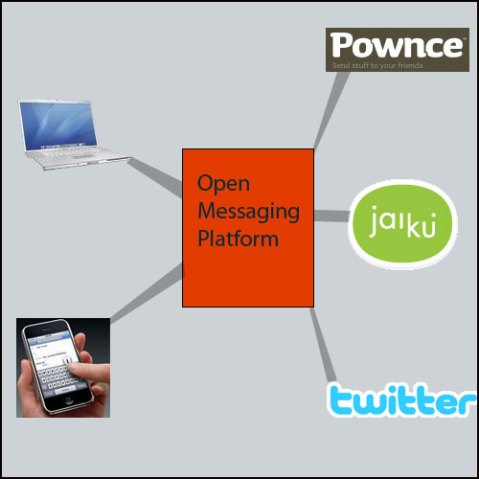Archive for the ‘social networks’ Category
Thoughts on an open messaging platform
Posted by: Paul on: May 8, 2009
Twitter in the microblogging world now has the pull of Google in the search world – if you’re not ‘on Twitter’ you’re nowhere inn terms of being able to connect, share and promote via microblogging (surmising that Twitter now gets 80 – 90% of microblogging traffic / use.)
This effectively locks the market into one monopoly platform – Twitter.
Imagine this applied to blogging or web publishing. Say there were many publishing services, you could only use one publishing service at a time and publishing service A had 90% of the total traffic and users.
If you weren’t using publishing service A, regardless of the quality of your content, you’d miss out on 90% of the traffic, connection or exposure just by being on a less popular service. Not a nice thought.

Would an open messaging platform – essentially a server application which allows you to create a master account and associate ‘child’ accounts to it for other microblogging services (Twitter, Jaiku et al) make any difference in leveling the microblogging playing field?
The idea is that the platform would broadcast your posts or ‘tweets’ to all your subscribed services, but would also aggregate posts from the users you’re following and stream them back to your ‘open messaging’ client.
Rather than ‘a twitter client’, you could have a general micro blogging client offering not only the power to broadcast your posts to multiple services, but to also aggregate the incoming messages regardless of what service they came from.
It wouldn’t matter what service someone you follow was using (surmising that you also had an account on that service), because in your microblogging client, you’d see one unified stream of updates regardless of the API they were built on.
Microblogging would become a standardised platform in its own right. Rather than having disparate API’s, an open messaging platform could seek and serve to unify microblogging API’s and REST-based services, or at least provide a simple bridging framework between them.
Thoughts on Twitter, Social Networks and one-way communication
Posted by: Paul on: February 21, 2008
I must admit I have a bit of a love-hate relationship with the way we communicate via the web. Facebook (and Bebo) were exciting due to the ability to find old friends and reconnect, as well as seeing what everyone else was up to.
The excitement soon faded when I realised the shallowness of the communication created by these social networks. Everyone was talking, but no one seemed to be talking to anyone else. ‘Pokes ‘ were given, people were ‘bitten’, hundreds of ‘friends’ were added, but the communication in these systems is overwhelmingly one-way. The irony is that a system designed to connect people with others ends up being an exercise in narcissism, with people only really interested in broadcasting what they are doing
It’s all about ‘I’m at work’, ‘I’ve added a new photo’, ‘I threw a Mongolian Wildebeest at Jimbo’. Think about it, if you really wanted to engage with one of your contacts on Facebook / Bebo / your-social-network-of-choice what would you do? It’s likely you’d private message them. Which is remarkably similar to….? That’s right – old fashioned email.
Twitter, which I use every day, is a perfect example of this. The very name says it all – it’s a ‘twitter’ of voices – short, snappy messages people broadcast to friends and followers which details what people are doing, where they are, and pretty much whatever else they wan to fit into 140 characters.
Despite it’s addictiveness, Twitter’s noise to signal ratio is even worse than your average social network. Twitter allows you to follow people and to see their comments in you twitter message stream, but these people have to opt-in to see your messages. To someone who follows a lot of people, but has few people following them, this gives the misguided appearance of being part of a conversation or chat, where the reality is that people you’re following have no idea of your contribution. Unless they choose to follow you, they simply can’t see it. It’s one-way traffic at it’s best.
Maybe I haven’t given these technologies enough time or effort, but I’m quickly becoming disillusioned and saddened by the shallow communication today’s ‘web 2.0’ technologies are fostering.
recent comments